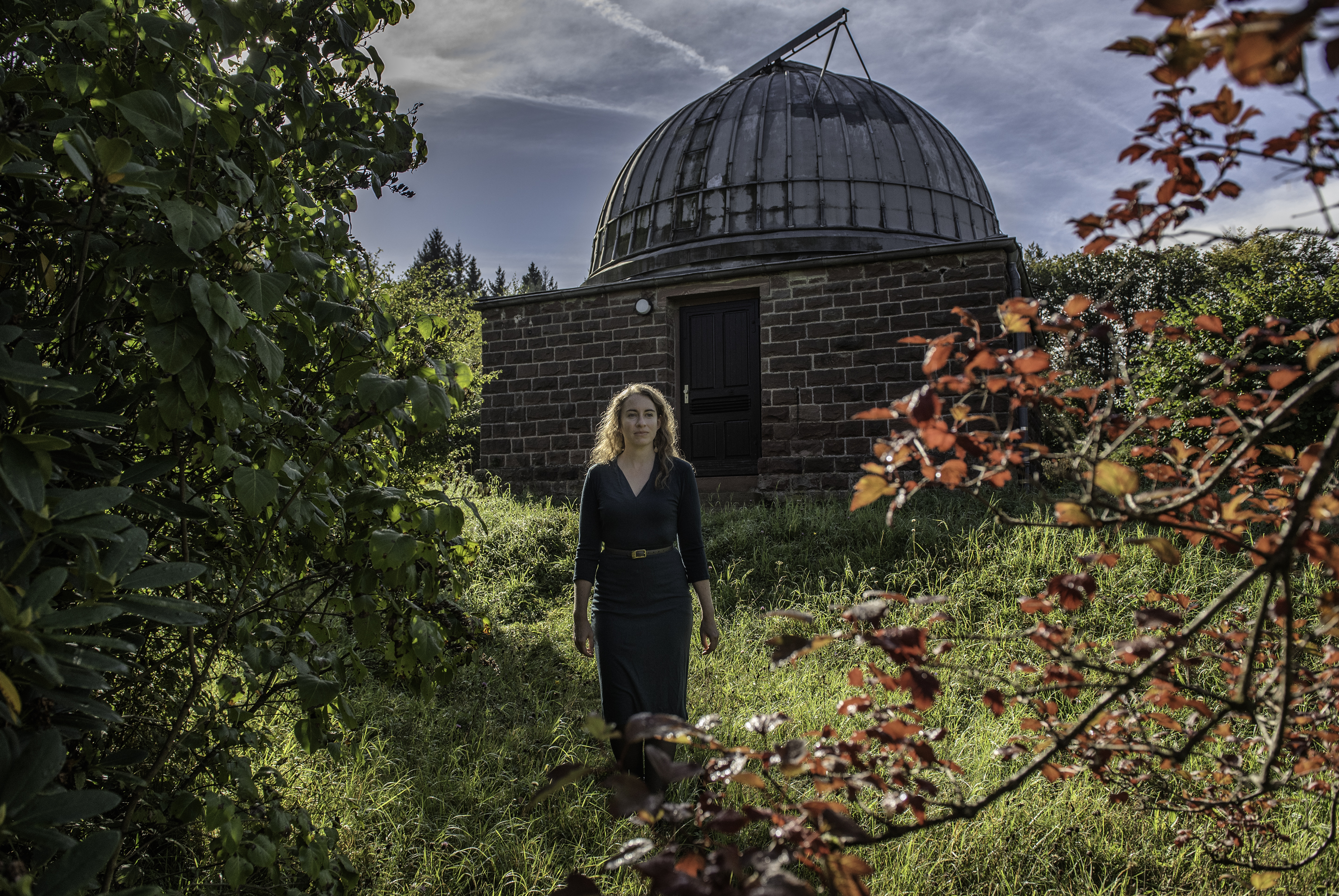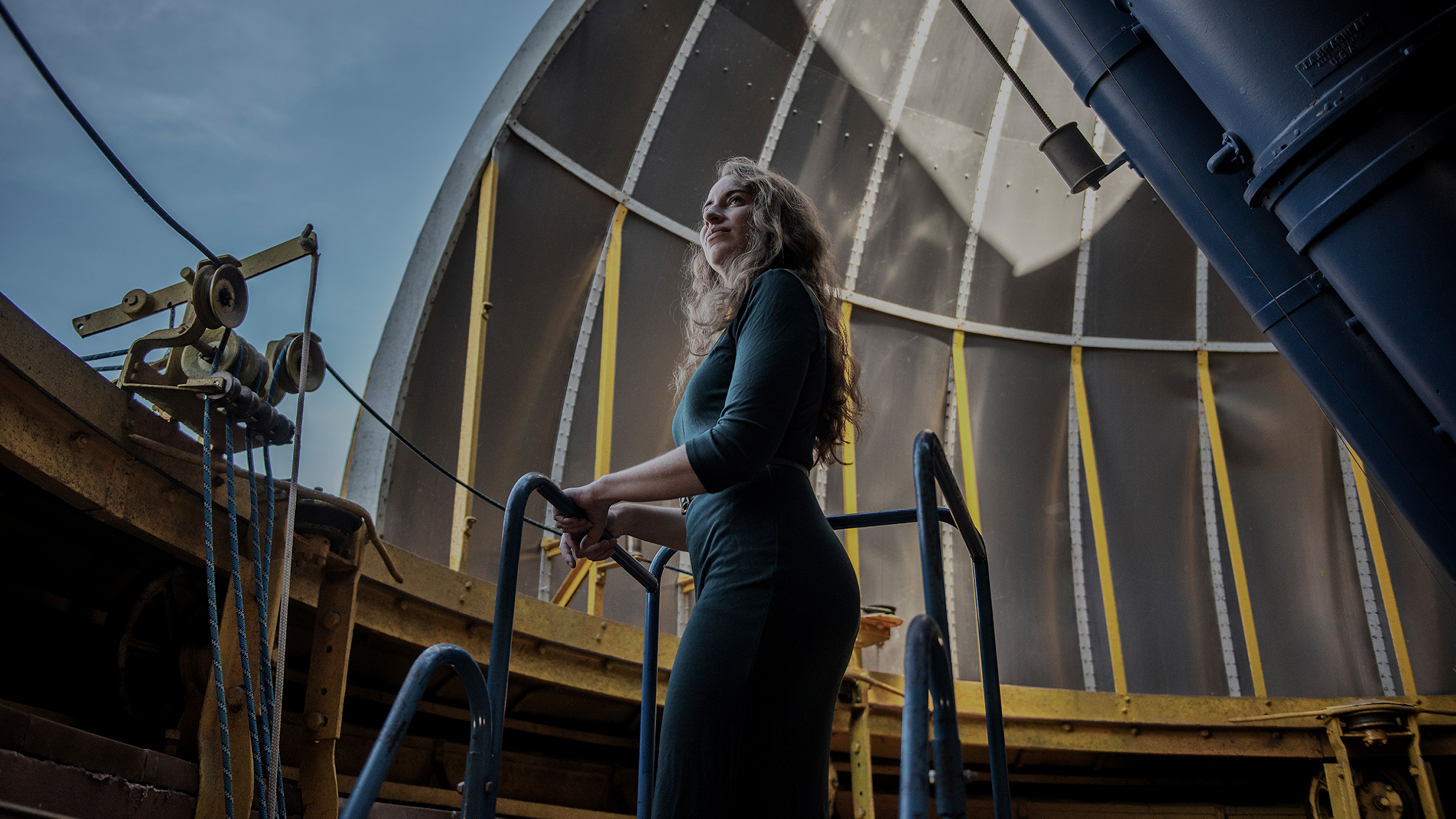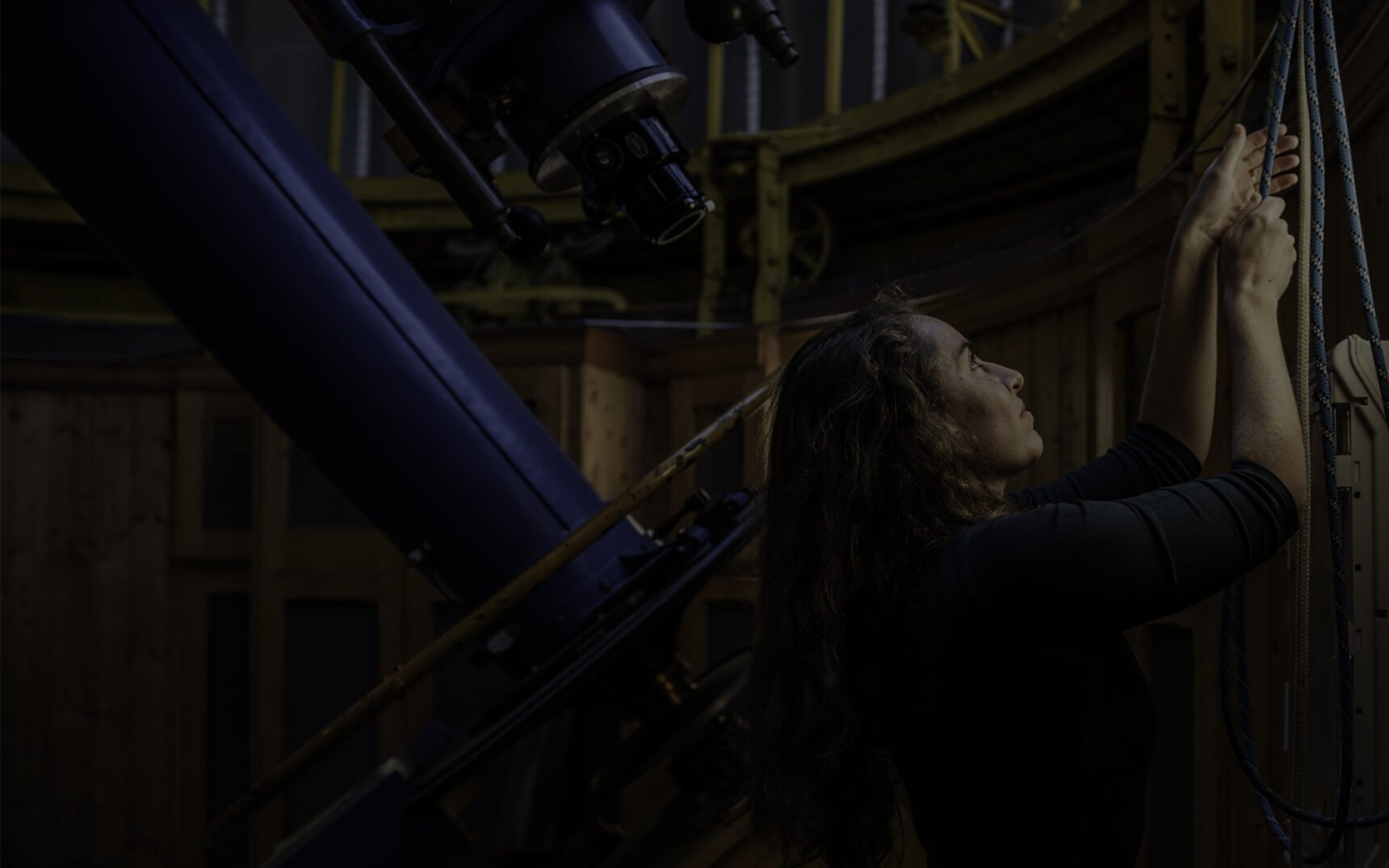The Astronomer Who’s About to See the Skies of Other Earths

Laura Kreidberg walks on the grounds of the Heidelberg-Königstuhl State Observatory in Heidelberg, Germany.
Laetitia Vancon for Quanta Magazine
Introduction
We know next to nothing about the other 6 billion or so Earth-like planets in the galaxy. With the imminent launch of the largest, most powerful space telescope ever built, Laura Kreidberg is optimistic this will soon change.
Kreidberg is the 32-year-old founding director of a new department at the Max Planck Institute for Astronomy in Heidelberg, Germany, devoted to studying what the weather is like on alien worlds. So far, she and her team have scrutinized the atmospheres around Jupiter-size exoplanets (planets orbiting other stars). When it comes to small, rocky exoplanets that could potentially harbor life, current telescopes lack the resolving power to do much more than tally the number that are out there. But NASA’s $10 billion James Webb Space Telescope (JWST), set to launch in December after decades of planning and construction, will allow astronomers like Kreidberg to peer into rocky planets’ skies and, she said, “turn these planets into places.”
JWST’s distinguishing feature is a sunshield the size of a tennis court that will protect its instruments and gold-plated mirrors from the heat of the sun and Earth. Shaded in this way, the telescope will be able to detect faint infrared radiation, such as the light coming from exoplanets. Kreidberg is the lead investigator for two programs in JWST’s coveted first round of observations. Her projects seek evidence of atmospheres and volcanic activity around Earth-size worlds.
Kreidberg, who grew up in Reno, Nevada, has been a rising star among exoplanet scientists since completing her doctorate in astronomy and astrophysics at the University of Chicago in 2016. The overarching question motivating her research on exoplanet atmospheres — work for which she won the Annie Jump Cannon Award earlier this year — is whether alien life exists in the cosmos. “The universe feels profoundly lonely,” she said. Discovering aliens “would be comforting, in a strange way.” Scientists suspect that life cannot survive on skyless planets, so investigating atmospheres around rocky planets is a key step toward answering the “Are we alone?” question.
During our conversation, Kreidberg laid out the ingenious methods she’ll use to observe far-off, pinpoint planets orbiting in the blinding glare of their parent stars. Despite her calm and meticulous manner, her excitement about the new telescope bubbled over: “We’ve been waiting for this for so long!” The interview has been condensed and edited for clarity.


Kreidberg explores the skies of other worlds from the idyllic Max Planck Institute for Astronomy in Heidelberg.
Laetitia Vancon for Quanta Magazine
A few thousand exoplanets have been spotted over the past couple of decades. What have we learned about them so far?
What was surprising was how much diversity there is. We have the idea from our solar system that there are the inner, terrestrial planets, and then there are the outer gas giants. Most other solar systems do not look like that. There are loads of planets that orbit really close to their host stars — planets which are so hot that the surface of the day side melts into lava. There’s a whole range of sizes. We’ve even seen planets orbiting two stars, like Tatooine in Star Wars. I don’t think anyone, no matter how creative, could have predicted this. People call it the “exoplanet zoo.”
So far, most of what we know about these planets we infer from their mass, radius and orbital period. But the next level of detail — like, what is the weather? What is the atmosphere made out of? Is a planet potentially habitable? All of that is just beginning now.
How will JWST further those kinds of investigations?
JWST is a dream come true for exoplanet astronomers. It’s the most ambitious space telescope ever built. I like to say that the JWST will be 10,000 times better than the Hubble Space Telescope. It’s a factor-of-10 bigger mirror, so with more light-gathering power you can observe things that are fainter; a factor-of-10 more wavelength coverage — well into the infrared where Hubble stops. Having the infrared wavelength coverage will let us push to much cooler and thus potentially more habitable planets than we’ve been able to study before, and it helps us see through the clouds on these planets. There’s also a factor-of-10 better stability, and a factor-of-10 better spectral resolution. That means we can see the exact wavelengths in the planet’s color spectrum that are getting absorbed by molecules in its atmosphere, which lets us determine the chemical composition of atmospheres more precisely.
What do we know about exoplanet skies so far?
Most observations so far have been for hot Jupiter-size planets. The real game changer will be JWST observations of rocky planets, which to date only have upper limits on their atmospheric properties. There’s all this promise of a huge abundance of these small planets, but it’s a major question mark whether their atmospheres can survive. There are some red flags. Most of the stars in the Milky Way are not like the sun; they’re relatively bright in ultraviolet light for the first billion years of their lives, so they could easily evaporate many Earth oceans’ worth of water from a planet. The only way to find out for sure is to go and look.
Tell me how the observing program you’re leading will attempt to do this.
It’s designed to figure out whether an atmosphere is present on a planet around the TRAPPIST-1 system, a star system 40 light-years away that’s famous for having seven roughly Earth-size planets. We can’t spatially separate the planet and star; they’re too close together. We only see the sum total of the brightness of the star and the planet. But I’m observing the planet when it passes behind the star, when the light shining from the planet is blocked. By measuring the change in total brightness, we can figure out how bright the planet is, which tells us its temperature.
The temperature is really sensitive to whether an atmosphere is there or not. If you have a thick atmosphere, it’s really good at transporting heat from the hot, illuminated side of the planet to the dark night side. If you have no atmosphere, all of this starlight hits just one hemisphere and you would measure a really hot day side. Whereas a cooler day side suggests an atmosphere is there.
It sounds tricky.
We’re looking for variations in the brightness of the star at the level of 100 parts per million. Every photon is precious because we’re pushing to such small signals.
Will you be able to say anything about what the atmosphere is made of?
If we learn that some atmosphere is present, the next step would be to figure out what it’s made of. With JWST, so long as the atmospheres are not too cloudy, we can observe their spectra. By observing starlight passing directly through the atmosphere we’ll be able to say whether it has water or methane or carbon dioxide in it. But we won’t be able to detect biosignatures, which are observable properties of a planet that can only be explained by the presence of life.
Why not?
The holy grail biosignature is chemistry that is out of equilibrium. For example, on Earth we have both oxygen and methane in the atmosphere. Normally, if you put those two gases together in the lab they would react with each other and form carbon dioxide and water. So the fact that we see both of those at the same time means that they must be constantly produced by something, and that something on Earth is life.
There is no planet known where JWST will have the sensitivity required to detect biosignatures like this. Oxygen is really challenging to detect because the features are small compared to other molecules. For observable planets that are in the habitable zone of their stars, even if there is much more oxygen than is present on Earth, we would still need dozens of transits of the planet in front of the star to detect it. Any added difficulty, like clouds in the atmosphere or instrumental noise from JWST, would make it prohibitive. We would basically need to get lucky in every possible aspect to have a prayer of seeing oxygen, and in my experience exoplanets are always tougher than expected.
That said, I’m really optimistic that we’ll see some of the easier-to-observe molecules, particularly carbon dioxide. While that isn’t a biosignature, it’s still an important piece of the puzzle of habitability.
How can we determine if alien life exists on exoplanets?
To answer a question as complicated as “Is there life there?” we need a big sample of planets to work with. A number of next-generation space missions are under discussion which are designed to directly take a picture of Earth-like planets. I believe that is what we need to do. But it’s also really, really difficult. This is kind of a career goal for me.
What’s your gut feeling about the existence of alien life?
I’m an optimist. To be in this field, you have to be. I’m certain that there is life out there somewhere. We already know that Earth is not that special, that there are loads of other planets that are the same temperature and size. And we also know that water is really, really common. Everywhere on Earth where we find water, we also find life. It’s an excellent solvent. We also know that life arose very quickly on Earth. Not long after the ocean stopped boiling and there was liquid water, you find the first fossil evidence of life. To me that is a sign that if you have the right ingredients and you wait long enough, you’ll end up with living beings.
Your other observing program with JWST will look for volcanic activity. Why is that worth looking for?
Volcanic activity is a good signpost for plate tectonics, and plate tectonics are thought to be a crucial ingredient for life on Earth. As the plates are subducted back into the Earth’s interior, you can remove carbon from the atmosphere. That’s what prevented the Earth from becoming a runaway greenhouse, like Venus did.
Securing observing time with this telescope must have been extremely competitive. Why do you think your observing programs were picked?
I was a little bit surprised that these were picked, because they were the most technically challenging of all the proposals I submitted. But there’s so much excitement about Earth-size planets that I think they were willing to do an observation that’s more ambitious. It’s a high-risk, high-reward type of observation.
I’d like to see more risk-taking, because we just don’t know what exoplanets are like at all. Probably all the models are wrong. I’m in favor of looking at the best planets that are out there, those with the largest signal, and seeing what we see. There’s no guarantee that we’ll find anything interesting. But many of the most exciting discoveries have been surprises, and if you don’t take risks, you won’t find surprises.

Kreidberg posing with an antique refractor telescope called the Bruce double astrograph, at one time the main research instrument in Heidelberg’s observatory.
Laetitia Vancon for Quanta Magazine
Shortly after the Hubble Space Telescope was launched in 1990, a problem was discovered in its mirrors. Fortunately, astronauts were able to make repairs. Are you worried something could go wrong with the JWST?
There’s definite concern. A particular challenge is that JWST has a sunshield that has to unfold perfectly in space. In contrast to Hubble, JWST is so far away that we can’t send somebody there to fix it.
Assuming everything goes to plan, when do you hope to have some results?
I’m optimistic that we’ll have data in six months. If history is any guide, there’ll be a pretty steep learning curve required to pull signals out from the raw data. I hope to have some answers for at least some planets within 12 months of launch. But it’s completely uncharted territory.
What keeps you going during these arduous observations and analyses?
One time in grad school I was studying the atmosphere of a hot, Jupiter-like planet. I was trying to get all of my data analysis perfect before I looked at the end result, because I was trying to be a good scientist and not bias the analysis. Finally I was on an airplane and decided: Now is the moment that I’m going to look.
Water was there loud and clear. I was so excited on this airplane! The person next to me thought I was totally crazy. I was like: “Look at this! Look at this!” And they were like, “OK, ma’am, please leave me alone.”
There’s no feeling in the world like being the first person to know something new about the universe. There are a few times where I’ve discovered water on a planet that no one had seen before. It feels like you’re hiking on an alien planet. That’s not something that happens so often in your career, but those are the moments that keep me going.
Correction: October 13, 2021
Due to an editing error, this article originally stated that Kreidberg received her doctorate from Yale University, rather than the University of Chicago. Her bachelor’s degree is from Yale.




